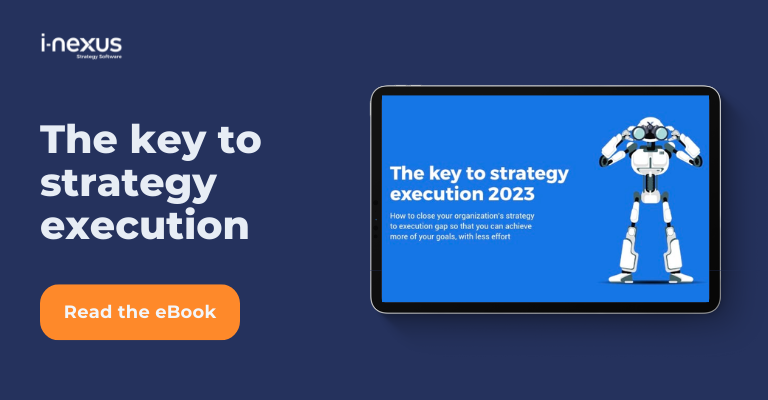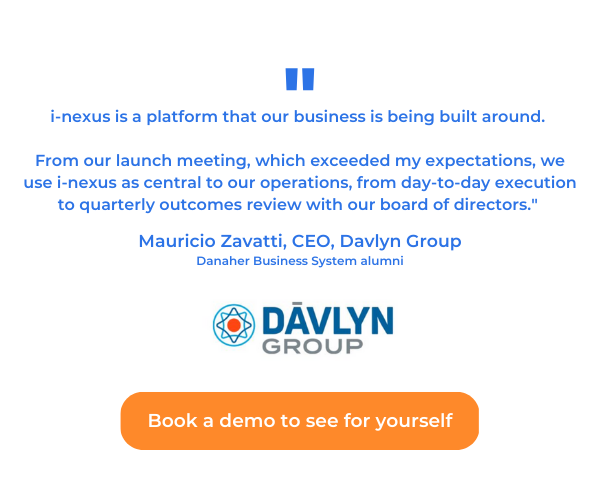What is a corporate strategy, why do you need one and how do you know if your strategy is right? Learn more about corporate strategy here.
Written by: James Milsom, Head of Marketing
What is a corporate strategy?
A corporate strategy is an organization's map to reach their long-term goals and objectives.
While issues may arise on the journey that require time and attention, with a strong corporate strategy in place the direction in which an organization is traveling should always be clear.
Corporate strategies are always evolving in response to the environment they operate in, and revolve around issues such as driving sustainable growth, stabilizing the company, or allowing you to reinvent an aspect of your business.
Here we delve deeper into the make-up of a good corporate strategy, and how to build your own.
What are the different aspects of corporate strategy?
There are five key components to creating a corporate strategy that we can look at in closer detail:
1. Identifying objectives
Without clearly defined objectives, you won’t be able to measure the progress and success of your strategy. When deciding your objectives, ensure they have a measurable, quantitative value and are set within a specific timeframe.
2. Structural design
This refers to analyzing the structure of a company to ensure that it is functioning in the most efficient way possible. Restructuring may be required as part of a corporate strategy to improve workflow and encourage productivity. This can range from updating company-wide hierarchies to reshuffling specific teams.
3. Portfolio management
Portfolio management involves looking at the different components of your business and ensuring that they are working well together and in the way you want them to. When managing your portfolio concerning corporate strategy, you may decide to invest strategically in new opportunities to better align with your goals or closely monitor your competitors to ensure you’re on trend.
4. Resource allocation
Your company likely has many resources; employees, materials, and money, to name a few. Resources will have to be allocated in a way that will best serve your corporate strategy - for example; this could mean committing more time and people-power to a particular task that’s likely to benefit the company significantly.
5. Strategic trade-offs
When presented with several avenues, each of which could potentially lead to growth and success for your business, it’s inadvisable to attempt to follow all of them at once. Strategic trade-offs refer to analyzing the risks of your potential strategies, deciding which is likely to create the highest ROI, and finding the balance between these two elements.
What strategies are there to choose from?
The type of strategy you choose will depend mainly on the position your business is in - if needs be, you can even combine two types of strategy with meeting your specific needs. Settling on what strategy will begin with a situational assessment using a tool like SWOT.
There are three main types of corporate strategies.
- Retrenchment
This type of strategy involves culling things from your organization that is unprofitable. It doesn’t purely refer to products, as there can also be unprofitable processes. It can also involve changing direction. - Stability
This is a strategy for an organization currently in a good place and wants to maintain its comfortable position while also keeping an eye out for future opportunities. - Growth
These strategies focus on looking for ways to grow, diversify, and find markets to expand into. Often vertical integration, which involves adding more value-rich areas to your business, is key to a growth strategy.
As mentioned above, you might even combine elements of these different strategies to benefit your organization’s goals better.
What makes a good corporate strategy?
You might think that the only way to tell whether a corporate strategy is good is by looking at whether or not it succeeds.
The truth is you can set yourself up for a higher chance of success with the right strategy, but unless this strategy is fully realized and successfully executed, there’s still a chance that it won’t be fruitful.
As well as being mindful of all of the elements listed above, a good, well-balanced corporate strategy is properly aligned with your organization's goals and understood throughout your workforce.
Not only should the links be clear between how your proposed strategy will benefit your business, but employees at every level should understand the role they have to play in its implementation.
How do I know if my strategy is right?
While teething issues and speed bumps are inevitable, you will hopefully see the effects of your chosen strategy before long.
Creating an effective corporate strategy is the first step, but data on your strategy's performance is paramount.
Collecting data highlighting changes to previous figures will make this easier.
And it pays to review your strategy and validate it continuously. Here's how to do that.
Corporate strategy example: medical device company
If we take a medical device company for a case study, the organization may pursue its corporate strategy in several directions.
One approach could be to focus on expanding the product portfolio via research and development. This may involve investing in new technologies, hiring experienced engineers and scientists, and forming partnerships with universities and research institutions to stay at the forefront of innovation.
Another strategy could be to target specific markets or segments, such as emerging economies or specialized medical fields, and tailor the product offerings and marketing strategies to meet the needs of those markets. This may involve developing more affordable or easier-to-use products or offering training and support services to healthcare professionals.
A third strategy could be prioritizing customer satisfaction and loyalty through excellent customer service and support. This may involve investing in training and support staff, developing user-friendly products, and offering customers extended warranties or other value-added services.
Creating a strong business strategy
You might think that the only way to tell whether a corporate strategy is good is by looking at whether or not it succeeds.
While your corporate strategy focuses on your organization's overall growth and health, business strategies keep you competitive in your industry and create value for your customers.
When highlighting the differences between what is corporate strategy and what is a business strategy, the main difference is usually the scale of impact.
Business strategies will often have shorter time frames than corporate strategies and quickly generate measurable results.
Aside from this, many elements of a good corporate strategy are also present in a successful business strategy:
1. Settling clear objectives
Corporate and business strategies hinge on creating SMART goals- specific, measurable, attainable, relevant, and time-constrained objectives. The main difference between corporate strategy objectives and business strategy objectives is scale.
2. Pivoting and updating
Reacting and adapting your strategy to a changing environment is essential if you want it to remain useful. For a business strategy, this may involve being able to respond quickly and update a campaign to cater to a new marketing trend, whereas, for a corporate strategy, this could mean adjusting a goal to meet a stakeholder’s expectations better.
3. Analyze the opportunity
For both strategies, the identification and assessment of opportunities are important - on the one hand, you don’t want to let a promising opportunity pass you by, but on the other, it’s important not to risk the success of a strategy by always looking to chase a new lead.
How to think differently about strategy
Whether you're clear on your strategic direction, want an example of a corporate strategy, or want to think outside the box - there's a wealth of resources out there.
Here are some of the best videos to watch:
1. Martin Reeves: Your strategy needs a strategy
"Is it possible to look ahead without stumbling over what’s before you? All too often companies spend precious time laying out long-term strategic plans, only to discover that their maps are out of date in a month.
Business strategy expert Martin Reeves offers a solution. He advocates transitioning from relying on a single "classical" approach to strategy and moving towards a more tailored approach to strategy and execution, selecting from 5 distinct patterns of success."
2. Simon Sinek on How to Improve Strategic Thinking
"Author and public speaker Simon Sinek answers "How Do You Make Strategic Thinking More Implementation Friendly?" To Sinek it comes down to language and the importance of using words people understand. When the language is simple, the directive becomes clear to everyone and can be more easily followed and implemented."
3. The Five Competitive Forces That Shape Strategy
"An Interview with Michael E. Porter, Professor, Harvard University. Porter's five competitive forces is the basis for much of modern business strategy. Understand the framework and how to put it into practice."
See how i-nexus can help with corporate strategy creation
The perfect strategy deserves exceptional execution. Take your first step by booking a demo and joining leaders like Mauricio in delivering growth beyond target and the S&P's rate.
Learn more about strategy creation
Click here to learn more about strategy execution, or take a look at these content recommendations:
- Key to strategy execution eBook: Read how companies like Danaher and HP have mastered strategy execution and what you can learn from them.
- What role does a Strategy Realization Office play in your strategy execution?: Learn how you can govern your strategy execution with the emerging concept of the Strategy Realization Office (SRO)
- 13 ways to make your team care about goals: Try these 13 ideas for getting your team to buy into your goals, and create real accountability for delivering targets.
About the author
James Milsom is Head of Marketing at i-nexus. James has wide-ranging experience in telecommunications, energy, education, and software markets.
As Head of Marketing, his drive is to raise awareness and understanding of the challenges facing enterprises in delivering strategic objectives and transformation amidst changing markets and the obstacles traditional tools and methods present leaders.
If you’d like to talk more about strategy execution, contact James at james.milsom@i-nexus.com or connect with him on LinkedIn for the latest insights.





